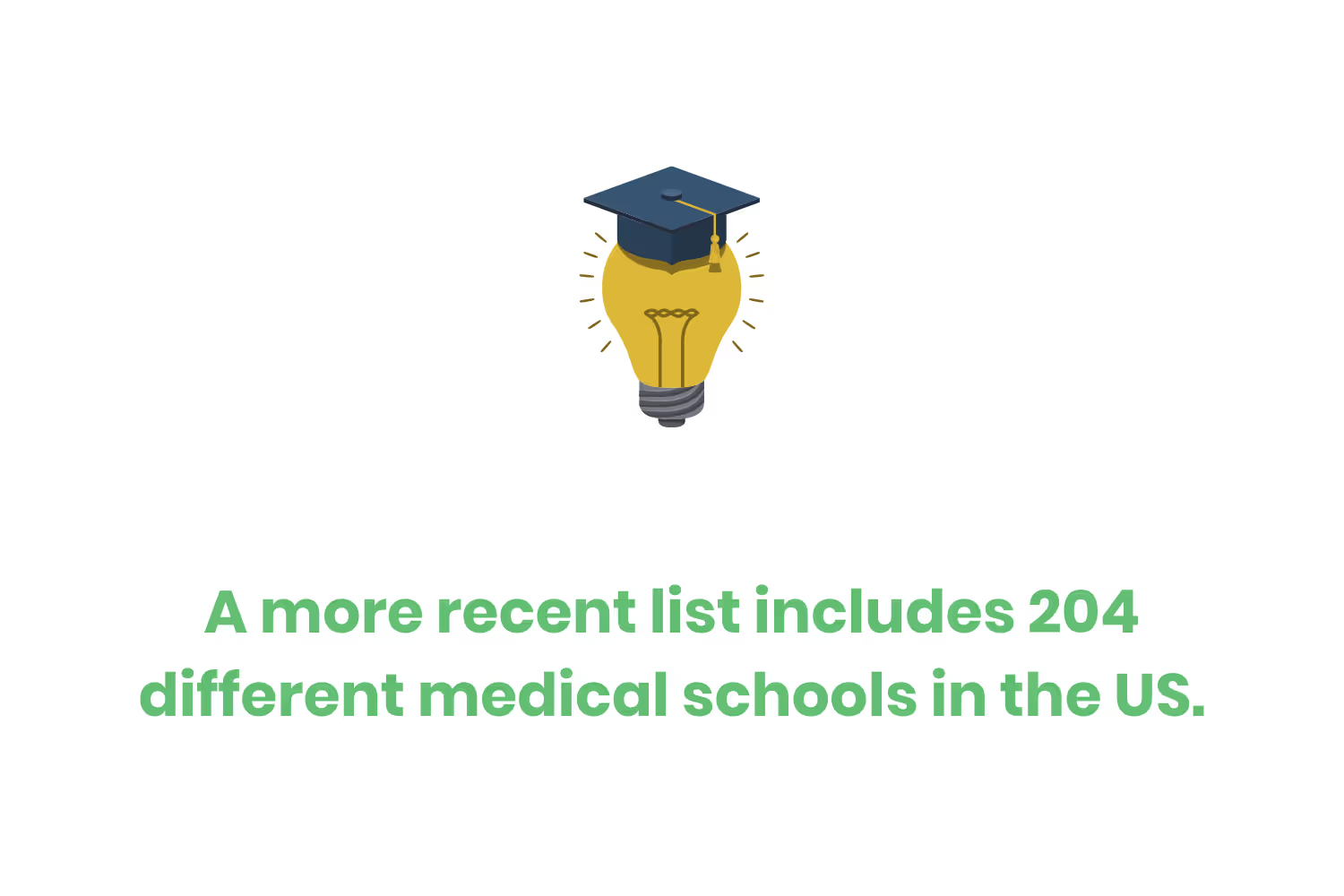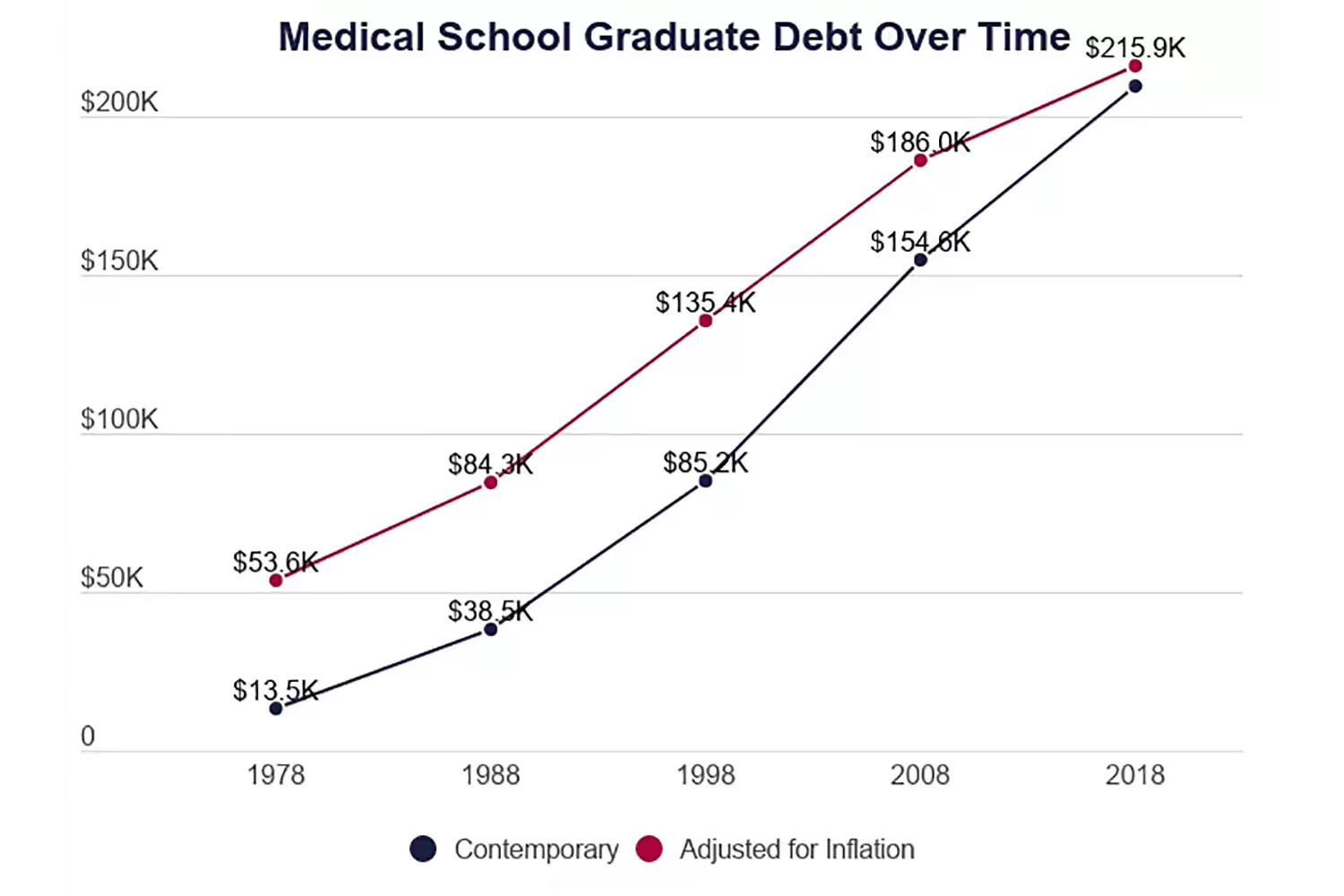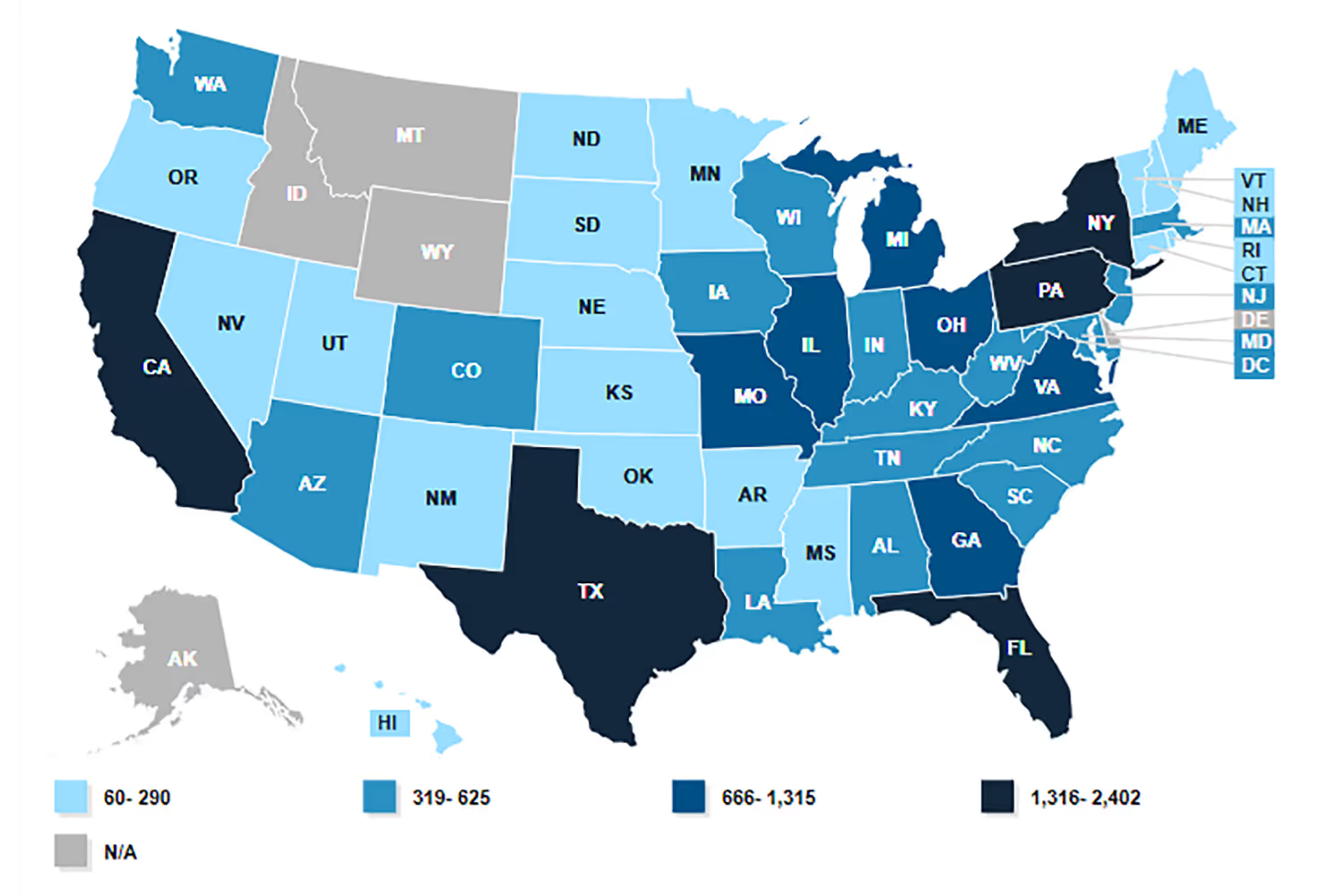45 Medical School Statistics Every Student Should Know
It’s no secret that medical school is an uphill battle. Here are 45 statistics that every student should know before, during and after their journey.

It’s no surprise that medical school is an uphill challenge.
Students need to be holistically prepared before they can become doctors. Not just anyone should be able to take care of vulnerable patients, which makes sense why it takes years of professional training.
Medical students try to help their peers succeed in their education through social media. But there will always be areas of the field that are tough to navigate.
There’s no one-size-fits-all advice for getting into a program. It depends on many factors such as GPA, MCAT scores, minimum MCAT score acceptance, and the institution that the person is applying to.
With all these factors, people end up applying to many places with the hope of getting accepted somewhere. But once they do, they start facing a new set of challenges such as picking a specialty, financing their education, and finishing the program.
Here are 45 medical school statistics that show stressors which students may face to reach their title.
Amount of Schools
The number of schools varies by state. As expected, the highest populated states have the most programs.
As of May 2015, there were 179 medical schools in the US. A more recent list includes 204. From the same list, New York has the most with 17 different options.

There are two different kinds of medical schools: allopathic (MD) and osteopathic (DO). Allopathic refers to the traditional approach to medicine to diagnose and treat diseases. Osteopathy uses a holistic approach to diagnosing rather than just treating symptoms.
Allopathic programs are more popular and make up a majority of medical institutions. There are 37 osteopathic schools, far fewer than allopathic.
Acceptance Rates
Whether a student gets accepted to a particular school depends on several variables. The grade point average and Medical College Admissions Test score both play a role in the likelihood of acceptance.
Every institution has different acceptance rates since each one has different score standards. Typically, there isn’t an official set GPA or score for each school.
But applicants should aim for at least the average which the schools’ matriculants have. So if the school has students who average a 3.8 GPA and a 514 MCAT, then applicants should aim for a minimum of those.
The average MCAT total score of all test takers is 500.

Everywhere accepts its own range, and people applying to more competitive options need to aim above the 90th percentile. This is above a 513 score.
Most schools require above the average total MCAT score. But seven schools in the US average 500. And 24 have a minimum requirement under 500.
It’s difficult to get accepted with a cumulative GPA of less than 3.0. Total applicants had a median cumulative GPA of 3.56, compared to the 3.71 GPA of already-enrolled students.

Two other deciding factors for admission are the popularity of the institution and how many applications it receives.
The overall acceptance rate for US allopathic programs is 7%, and 10.25% for osteopathic. Of course, this changes depending on how popular the school is. Those with many applicants generally have a lower acceptance rate.

Because of limited admissions, pre-meds will apply to many programs. For 2018-2019, each pre-med averaged 16 applications.
Number of Students
Acceptance rates dictate the total number of medical students. Both the number of applicants and total students enrolled continues to increase.
Enrollment is up 31% since 2002. First-year medical students increased by 1.7% in 2020, and the number of applicants for the 2021 academic year is up by 18%.
The program with the highest attendance for 2019-2020 was Lake Erie College of Osteopathic Medicine in Pennsylvania. It had a total enrollment of 2,252, and there were 577 first-year students.
The amount of women in medical school is increasing, too. Since more women are applying, more get accepted. They now outnumber men in these programs. As of 2019, there were 27,848 women applicants compared to 25,494 men. Enrollment was 50.5% female.

Image source: AAMC
Length of Schooling
It makes sense why it takes so long to become a doctor. The graduate program follows a typical four-year undergraduate degree. After undergrad, it takes another four years to complete medical school. But it doesn’t stop there.
Following graduation is residency. This is as little as three years for the most common practices, such as family practice and internal medicine. But other specialties may require up to seven years. So on average, it takes at least 11 years to complete all training.

For those who aren’t in a hurry to start their practice, they may decide to do a fellowship to get more education. This is one to two years of experience.
Cost of Education
College is expensive as it is, so an extra four years adds a significant cost. Some students already have undergraduate debt. And they have even higher tuition during graduate programs.
Tuition, fees, and health insurance costs for medical students ranged from $37,556 to $62,194 for 2019-2020. The lower end was for public, in-state institutions and the higher end was for public, out-of-state. The average private school rates were between $60,665 and $62,111.
The average debt per medical student is $241,600. Between 76% and 89% will graduate with educational debt. And 43% also have pre-medical school debt.

Residency Programs
Following graduation is residency. This is when graduates get their experience in a specialty. They also start getting paid during this program. Their pay is less than what they’ll be making as a doctor, yet they work longer hours.
Residents may spend up to 80 hours per week working in the hospital. They work single shifts that routinely last up to 28 hours, required about four times per month. This is less than practicing doctors who may work fewer than 60 hours per week.
The average resident salary for 2020 was $63,400. This was a $2,200 increase from 2019. Pay is dependent on specialty.

Internal medicine is the most popular specialty with just over 10,000 resident applicants. Family medicine is the second most popular with 4,402 applicants in 2018. And pediatrics is third with 3,059 applicants.
Unfortunately, residency programs can be difficult to find. There were 517 programs in the 2018-2019 academic year. The number of available options depends on the state, and some states don’t have enough to accommodate students.
A survey found that 44% of medical school deans had concerns about students’ ability to find a program. Of these deans, 68% had concerns about availability in their states, and 75% had concerns about national availability.
Graduation Rates
An overwhelming majority of those who start medical school end up graduating, but not all do. Those who choose to do a longer program have higher rates of graduation.
Around 82% to 84% of all four-year students will graduate. But almost 96% of six-year medical students graduate.
The variation of people who fail out is large. It’s between 7% and 35% based on yearly graduation rates. The rate of failure depends on years in the program, single or combined years, and personal issues.
Between allopathic and osteopathic programs, there were a total of 25,955 graduates in 2018.

Unsurprisingly, New York had the most of any state with 2,402. This makes sense since the state also has the most programs.
Conclusion
Even though becoming a doctor is a long and expensive process, more people are choosing to apply to and attend medical schools. The likelihood of getting accepted depends on multiple factors, so it can be stressful when applying. This is why pre-meds send so many applications to increase their chances of acceptance.
Once they get in, they face new challenges such as educational debt and the ability to stay in the program. While it’s likely that most will graduate, there’s a wide range of some who won’t.
It can also be difficult to find a residency, though some states have more availability. And while residency is time-consuming, they do get compensation for this work.
Emphasize your product's unique features or benefits to differentiate it from competitors
In nec dictum adipiscing pharetra enim etiam scelerisque dolor purus ipsum egestas cursus vulputate arcu egestas ut eu sed mollis consectetur mattis pharetra curabitur et maecenas in mattis fames consectetur ipsum quis risus mauris aliquam ornare nisl purus at ipsum nulla accumsan consectetur vestibulum suspendisse aliquam condimentum scelerisque lacinia pellentesque vestibulum condimentum turpis ligula pharetra dictum sapien facilisis sapien at sagittis et cursus congue.
- Pharetra curabitur et maecenas in mattis fames consectetur ipsum quis risus.
- Justo urna nisi auctor consequat consectetur dolor lectus blandit.
- Eget egestas volutpat lacinia vestibulum vitae mattis hendrerit.
- Ornare elit odio tellus orci bibendum dictum id sem congue enim amet diam.
Incorporate statistics or specific numbers to highlight the effectiveness or popularity of your offering
Convallis pellentesque ullamcorper sapien sed tristique fermentum proin amet quam tincidunt feugiat vitae neque quisque odio ut pellentesque ac mauris eget lectus. Pretium arcu turpis lacus sapien sit at eu sapien duis magna nunc nibh nam non ut nibh ultrices ultrices elementum egestas enim nisl sed cursus pellentesque sit dignissim enim euismod sit et convallis sed pelis viverra quam at nisl sit pharetra enim nisl nec vestibulum posuere in volutpat sed blandit neque risus.

Use time-sensitive language to encourage immediate action, such as "Limited Time Offer
Feugiat vitae neque quisque odio ut pellentesque ac mauris eget lectus. Pretium arcu turpis lacus sapien sit at eu sapien duis magna nunc nibh nam non ut nibh ultrices ultrices elementum egestas enim nisl sed cursus pellentesque sit dignissim enim euismod sit et convallis sed pelis viverra quam at nisl sit pharetra enim nisl nec vestibulum posuere in volutpat sed blandit neque risus.
- Pharetra curabitur et maecenas in mattis fames consectetur ipsum quis risus.
- Justo urna nisi auctor consequat consectetur dolor lectus blandit.
- Eget egestas volutpat lacinia vestibulum vitae mattis hendrerit.
- Ornare elit odio tellus orci bibendum dictum id sem congue enim amet diam.
Address customer pain points directly by showing how your product solves their problems
Feugiat vitae neque quisque odio ut pellentesque ac mauris eget lectus. Pretium arcu turpis lacus sapien sit at eu sapien duis magna nunc nibh nam non ut nibh ultrices ultrices elementum egestas enim nisl sed cursus pellentesque sit dignissim enim euismod sit et convallis sed pelis viverra quam at nisl sit pharetra enim nisl nec vestibulum posuere in volutpat sed blandit neque risus.
Vel etiam vel amet aenean eget in habitasse nunc duis tellus sem turpis risus aliquam ac volutpat tellus eu faucibus ullamcorper.
Tailor titles to your ideal customer segment using phrases like "Designed for Busy Professionals
Sed pretium id nibh id sit felis vitae volutpat volutpat adipiscing at sodales neque lectus mi phasellus commodo at elit suspendisse ornare faucibus lectus purus viverra in nec aliquet commodo et sed sed nisi tempor mi pellentesque arcu viverra pretium duis enim vulputate dignissim etiam ultrices vitae neque urna proin nibh diam turpis augue lacus.


.avif)

